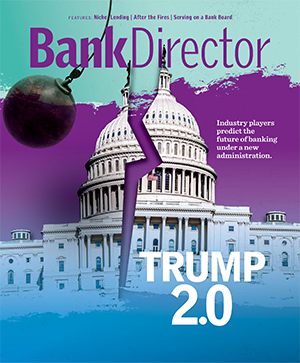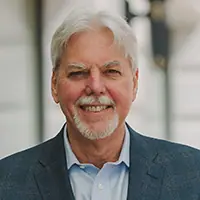
Should Your CEO Also Be Chairman?

This is one of the most sensitive issues that the board at any publicly owned bank can have to deal with. It’s fair to assume that most CEOs would prefer to hold the chairman’s title as well since it confers on them a great deal of power. If they were honest, most CEOs would probably admit that they would be a little threatened by the presence of a strong independent chairman—especially if this was someone they didn’t know very well.
The argument in favor of splitting the titles is that it’s a conflict of interest to have the CEO—who is answerable to the board—also in charge of the board. Most companies that still combine the roles have appointed a lead director whose job is to represent the views of the other independent directors, but in my experience most lead directors don’t carry the same clout as a chairman. It might be the same difference as between, say, an ambassador and a boss.
In an era of greatly heightened performance expectations that all public company boards face today, serving as CEO and chairman is a big job for just one person. This is particularly true in banking, where the federal regulatory authorities have a much higher expectation for board performance than they probably did 20 years ago when rubber stamp boards were more common. To run a bank in today’s highly competitive and heaving regulated environment, while also managing a highly engaged board, might be expecting too much for most CEOs.
Of course, splitting the roles is no guarantee that the company’s financial performance will improve. For all the criticism that Moynihan has received from Wall Street for Bank of America’s lackluster financial performance in recent years, this institution was profoundly impacted by the financial crisis and I think’s it’s debatable whether another CEO would have done significantly better dealing with all of its many problems than he has.
It also takes a special kind of person to serve as an effective independent chairman. They are not the CEO’s friend, but they also must be careful that the relationship doesn’t become adversarial. The best combinations of CEOs and independent chairmen that I have observed seem to be built on trust and mutual respect for each other’s role. And for the independent chairman, working with a CEO requires a delicate balancing act where personal chemistry and communication skills are vitally important.
There well might be other reasons Moynihan didn’t want to give up his chairman’s title. It would no doubt have seemed like a rebuke from shareholders that at the very least would be embarrassing. I always thought this was one reason why Jamie Dimon, chairman and CEO of JPMorgan Chase & Co., fought so hard to retain his chairman’s title in 2013 when a shareholder proposal to split the CEO and chairman roles came up for a vote at the company’s annual meeting that year. JPMorgan Chase’s shareholders ultimately voted to let Dimon keep both jobs.
Another reason why Moynihan fought to keep both jobs is survival. Remember Vikram Pandit, the former CEO at Citigroup? Pandit resigned as CEO in 2012 after reportedly clashing repeatedly with Citi’s strong willed independent chairman, Michael O’Neill. Citi’s financial performance was under the Wall Street microscope at the time and its board was reportedly underwhelmed by Pandit’s performance as CEO. In the end, Pandit might have resigned on the assumption that he was soon to be pushed out anyway. I would imagine that Brian Moynihan didn’t want to find himself standing at that same ledge.



